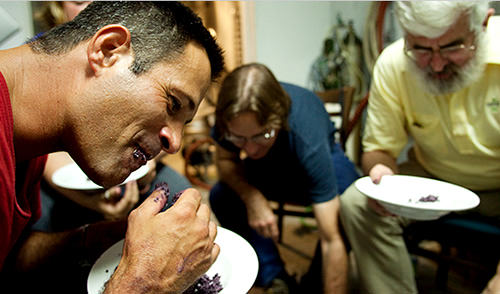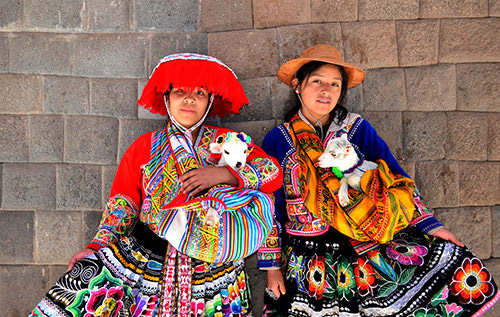Most often in life, when we’re handed a beverage—a nice lager, say—we don’t have to look up at our host, stare into his or her mouth, and wonder just how much spit they used to ferment it. Also, prudently, what they’d been chewing recently. If you’re in Peru, on the other hand, the story’s a bit different.
Peru is among several cultures that learned early the power of spit in the production of alcohol, and they’ve been hocking loogies ever since. (Not really. Sort of.) Peru is home to at least a couple ancient fermented beverages—namely chicha and masato—that originally depended on the power of human spit to kick-start fermentation.
Before you start chewing on apples, hoping to make cider, let’s get one thing straight: unless you’ve just sucked back a packet of Fleischmann’s, there isn’t yeast in your mouth. (Also, spit that Fleischmann’s out, for god’s sake.) Yeast feed on sugar to produce—really excrete—alcohol. Meaning your mouth, alas, is not a distillery.
The reason your spit, and my spit, and anyone’s spit can potentially kick-start fermentation is because it contains enzymes that can break unfermentable carbohydrates down into sugar. And that means wild, ambient yeast (the little guys responsible for our discovery of fermentation) can feast on those sugars and create alcohol for us. So we’re guessing that someone, somewhere along the way thousands of years ago, was maybe chewing choclo, or Peruvian corn, and maybe spit it out, and maybe later came back to find the corn kernel a bit fizzy (we’re not really sure what spit-kick-start-fermented Peruvian corn would look like, but fizzy seems like a good guess).
However it happened, ancient Andean peoples began making fermented beverages out of two major local heavy starch sources: aforementioned choclo, and yucca. And the resulting drinks, chicha and masato, have been around ever since. Literally, for millennia, which, whether or not you get behind the spitting thing, is incredibly impressive.

Chicha, or “chicha de jora,” is not to be confused with “chicha morada.” Both are made with purple Peruvian corn, but the chica morada is a non-alcoholic (non-spit) drink that’s made with pineapple and cinnamon. Chicha de jora starts with the same corn, but instead of boiling it, the corn is chewed up and spit and then fermented into a kind of beer. Inevitably, Dogfish Head founder and avid booze archaeologist Sam Calagione actually imitated and served this beer at his Rehoboth brewery.
As for what the chicha tastes like? Well, according to at least one intrepid traveler, who found chicha de jora by the common signal of a red flag (or red plastic bag) hung outside of a dwelling, chicha tastes “sour,” “like beer.” And, is incidentally, 6% ABV. Not bad considering the glass cost about $.20.
Masato is similar to chicha, but made with yucca. Because yucca has so much starch but very little available sugar, the same method—chewing and spitting—was adopted, though in the case of yucca the stuff has to be boiled first on account of its toxicity when raw (seriously, we didn’t know either). Like chicha, masato was probably created thousands of years ago, though it’s hard to gauge since ancient Peruvians weren’t in the habit of writing things down. According to a National Geographic writer visiting the Peruvian rainforest, “one of the earlier references to masato was written by the Spanish historian Antonio de Leon Pinelo” in 1636, in a book about Latin American cuisine. Among other recipes, Pinelo “describes…an alcoholic drink made when ‘girls chew the goo and set it aside in a glass.’”
The goo factor is, well, mildly stomach churning. But the girl factor is really interesting. Women were in charge of the production of both chicha and masato. And while their place in ancient Peruvian culture wasn’t prominent, the quality and manner in which a drink was served could be construed as a woman’s way of expressing her anger, or approbation.

We would say not to piss off your wife because then she’ll spit in your food, but here maybe it was the opposite: cross me and I won’t spit in your food. We should actually say “is,” since both masato and chicha are consumed to this day.
If you’re so inclined (and sanitary conditions and Hepatitis B can be real issues for tourists, so think twice), getting authentically made masato or chicha will take some doing. Most chicha nowadays is made in the traditional beer method, with malted barley. But if you have a sense of adventure and immunizations, find yourself wandering the smaller streets or vaster wilds of Peru and spot a red flag, check your pocket for a couple dimes. You might just get a real taste of Peru and its people. Literally.
Image of Quechua women via Allik / Shutterstock.com
